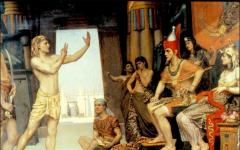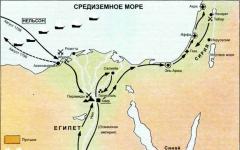So, I suggest finding the result of the example in pairs using your rulers.
Whoever has the result ready will raise his hand.
How much did you get?
- Guys, what have we done now?
What should I do if I find myself in another class and I don’t have as many rulers. How can I get out of this situation?
(Summarize that this can be done using number lines or rays).
Is it possible to show this on the board how I will need to act?
Fine. You taught me. Tell me, is it convenient for one person to use rulers?
So what should we do? After all, our task was to learn how to quickly and correctly add long examples? ...
Which?
Fixation on the board using the sign:
3. ??? |
I'll give you a hint. Can we do this on one straight line? How do you think?
This diagram clearly shows how these actions can be performed on one number line.
We will count down the measurements (our steps) with you. When we add and count the steps we go, in what direction for our case?
What do you think is the word in mathematics for this method?
Tell us how you did the addition?
Fine. When we add, we count the measurements and step to the right. What if I suddenly need to do a subtraction?
What do you think this method is called in mathematics?
You are real researchers and inventors! And everyone who discovers something new receives a reward for it. Your reward is also waiting for you. She's closer than you think. And if you carefully examine your workplace, then you will find it. Good luck to you!
Look at the board. What will you do now?
6+5+2+3=
What needs to be done for this?
Fixing the plan on the board:
- Straight or beam
- Measure, direction, beginning.
- Number 6
- Let's count 5
- Let's count 2
- Counting 3
- Let's find the result.
What is the name of what we recorded?
Those guys who can do it on their own work on their own, and those who find it difficult can work in pairs.
Independent work of students
What is the result of addition called in mathematics?
How much did you get?
Is it possible to calculate the result without a number line or ray? How?
Get into groups. Each group has a card with a task. The task is the same. Let's read it out loud.
What is this problem about?
What were they doing?
How?
How many were sitting on the first tree?
How do you understand the words the same amount?
- What is said about the second tree?
What does the problem ask?
Which scheme is suitable for solving this problem. Choose from those offered.
1) 2)
3) 4)
The diagram that is suitable for this task should be cut out and glued to the control sheet.
Complete the diagram.
Below on this sheet a formula for solving the problem should be drawn up and written down.
Let's check how you coped with this task.
Representatives of each group approach the document camera.(Demonstration of group work)
Guys, let's go to our seats.
Tell me, what remains for us to do while working on the task?
Plug in the numbers, solve and write down the answer.
Write down the solution and answer in your notebook yourself.
How do you find the result of addition, what will help you? (What is the name of this instrument)
- What task was given in the lesson?
Have you completed it completely?
What difficulties did you encounter and why?
What will you work on in subsequent lessons?
*I know and can add it myself.
*I can teach someone else.
Who feels like they have grown over the lesson?
What do you think we will do in the next lessons?
Choose a card of the level you can handle:
“Adding and subtracting numbers” - Auxiliary memorization techniques. Combinative law of multiplication. Results of the topic “Addition and subtraction”. Commutative law of addition. 3rd grade? route guide. Distributive law. 2nd quarter. Getting to know three digit numbers. Calculations in 3rd grade. Conscious execution of calculations. Discharge composition.
“Number as a result of measuring a quantity” - “Number as a result of measuring a quantity” mathematics lesson in 1st grade. Measuring the length of a segment using a measuring stick.
“Tolstoy Two Brothers” - We will disappear for nothing - we will disappear in vain We will remain with nothing - we will be left with nothing. To warm up. Fable Epic Tale Play. Without looking back - very quickly. He opened a school in Yasnaya Polyana for peasant children in 1859. Working on the 2nd part of the fairy tale. L.N. Tolstoy 1828-1910. Fairy tale. My memory is strong. Nearby (near).
"Addition of negative numbers" - Sum of two negative numbers is always greater than each of the terms. The sum of two negative numbers is always positive. Example: -8.7 + (-3.5) = - (8.7 + 3.5) = - 12.2. Blitz - survey. Lesson Addition of negative numbers. Physical education minute. Rene Descartes. The history of the emergence of negative numbers. The sum of two negative numbers is always negative.
“Addition of numbers, grade 1” - Consolidation of what has been learned. Compose and solve the problem: Before you is a series of numbers: 10 11 13 16. How much more is 16 than 10? Educational: teach students the method of addition by passing through tens in “parts”. “A general technique for adding single-digit numbers by passing through ten.” "Chain". Try to understand everything and count carefully!
“Two frosts” - They whistled, clicked - and ran. Frost - Blue Nose shook his head and said: - Eh, you are young, brother, and stupid. And you run after the merchant. How can we have fun - freezing people? The older brother, Frost - Blue Nose, chuckles and pats his mitten against his mitten. Let him, as soon as he dresses, find out what Frost is like - Red Nose.
Two “summands” in a row
They stand behind each other.
Following them is the equal sign -
We have known him for a long time.
What do we get in the end?
We call it “sum”.
Name the second term. Two.
Find the sum of the numbers four and one. The sum of the numbers four and one is five.
Give each number in this entry a mathematical “name.”
Addend, addend, sum.
How many fish did the old man catch? Six.
How many fish is the cat trying to eat? Two.
Right. Six minus two equals four.
- In mathematics, the number six in such equalities is called the minuend, the number two is called the subtrahend. ,four – difference .
The writing of the numbers “six minus two” reads: “The difference of the numbers is six and two.” This means that the number that is reduced is called the minuend, and the number that is subtracted is called the subtrahend. The result is the difference.
Even though I take everything away from everyone,
But this is not a problem at all.
I'm fulfilling my role,
And this, believe me, is not out of malice.
Therefore you should know
that the components are all important.
Minuend, subtrahend, difference.
Name the minuend. Eight.
Find the difference between six and one. The difference between six and one is equal to five.
Give the numbers in the example their mathematical “name.”
Physical education minute
The wind blew and they flew.
We were flying, we were flying
And they sat down quietly on the ground.
The wind came again
And he picked up all the leaves.
Spun and flew
And they sat down quietly on the ground.
Updating knowledge 3
4. Consolidation of knowledge
Suddenly the tent
It opened... and the girl,
Shamakhan queen,
All shining like the dawn,
She met the king quietly.
What fairy tale are these lines from?
That's right, "Golden Cockerel".
Vasya had three books. They gave him 2 more books. How many books does Vasya have? That's right, five. Write down this example. Name the first term – three; the second term is two; the amount is five.
○ ○ ○ ○ ● ● □ □ □ □ □ ■ ■ ■ ▲ ▲ ▲ ▼ ▼ ▼ ▼
4 + 2 = 5 + 3 = 3 + 4 =
Name the first and second terms and write down the total.
The first term is four, the second term is two, the sum is six.
The first term is five, the second term is three, the sum is eight.
The first term is three, the second term is four, the sum is seven.
The minuend is nine, the subtrahend is two. Write down the difference of these numbers and calculate it.
The minuend is equal to four, the subtrahend is two. Write down the difference and calculate.
Write down the difference between the numbers five and two and find its value.
Eight goldfish swam in the sea. One of them swam away. How many fish are left?
That's right, seven.
Subtract one from eight and it becomes seven.
There were four titmice sitting on a branch. Two more came to them. How many birds are there?
That's right, eight. Add two to four and you get six.
There were nine bunnies sitting in the clearing. Two of them ran into the forest. How many bunnies are left in the clearing?
That's right, seven. Subtract two from nine equals seven.
Five boats at the pier
The wave rocked them merrily.
Fishermen took three boats
To cross the expanse of the river.
How many boats are there at the pier?
Was the wave still pumping?
That's right, two.
Subtract three from five equals two.
4) Independent work.
1< □ 2 < □ 3< □
6 < □ 7 < □ 5< □
Write down the number on the right that is one more than the given one.
Test yourself.
1< 2 2<3 3<4
6<7 7<8 5<6
5 – 2= 5- 1- 1 = 2
Find the difference using the sample.
Test yourself.
3 - 2 = 3 – 1 – 1 =1
6 - 2 = 6 - 1 – 1 = 4
7 - 2 = 7 – 1 – 1 =5
Mom squirrel for kids
I collected a dozen cones.
I didn’t give it all away right away,
She gave one of everything:
For the eldest - spruce,
Middle - pine,
For the youngest - cedar.
(How many cones does mommy squirrel have left?)
Test yourself.
Draw a line segment of four centimeters.
4) Ingenuity challenge
There are three apples in the basket. How to divide them between the three princesses so that one apple remains in the basket?
You need to give one apple with the basket.
3 Summing up
We recognized the hero of the fairy tale A.S. Pushkin? This is Balda from the fairy tale “The Tale of the Priest and His Worker Balda.” Help him put the equalities into baskets.
You need to put the differences in the first basket, and the amounts in the second.
I hope that after this lesson you will want to re-read the fairy tales of A.S.
Pushkin. They will teach you a lot.
Pushkin's fairy tales live in the heart,
They bring joy and light to all children!
They will help you and me again
Admire the magical land!
Reflection
Continue the sentence:
I found out...
I can...
It was difficult for me...
Choose a picture that matches your mood.
This is an operation on two numbers, the result of which is a new natural number, obtained by increasing the value of one number by the value of another number.
Add two natural numbers- means counting as many units to the first number as are contained in the second number.
Example 1. Mom brought home several apples in two bags. There were 3 apples in one bag, and 2 in the second. How many apples did mom bring home?
To answer this question, when taking apples out of bags, you need to count them at the same time, for example, laying out apples from the first bag, say: one, two, three, and then, taking apples out of the second bag, continue: four, five. So there are only 5 apples.
When listing the apples, we added the number of apples from the second to the number of apples from the first package and got the total number of all apples, i.e. 5.
Example 2. Add two numbers: 4 and 2.
Solution:
Let's count all the units of the second number to the first number: add one more to four units, you get five units, add one to five, you get six. Thus, from the two given numbers 4 and 2 we got a new number 6, containing four units of the first number and two units of the second, i.e. as many units as there were in both numbers.
The numbers to be added are called terms, and the result of addition, i.e. the number resulting from the addition, is called amount.
To write addition, use the + (plus) sign. It is placed between the terms. For example, the entry 2 + 5 means that the numbers 2 and 5 are added. To the right of the addition entry, put an = (equal) sign, after which the sum is written:
Addition is an action that is always doable, that is, no matter what natural numbers we take as terms, we can always find their sum.
| New on the site | | | contact@site |
| 2018 − 2020 | website |
The result of adding two or more numbers is called amount, and the numbers themselves - terms.
Sum of two negative numbers. We add the numbers, similarly to the positive ones, and write the result with a minus sign. For example, (-6)+(-5.3)=-(6+5.3)=-11.3.
Rearranging the places of terms does not change the suma+b=b+a.
Subtracting numbers
The result of the action is called difference. The numbers themselves - minuend And subtrahend.
Adding a positive and negative number- this is nothing more than subtraction! Few people think that the subtraction of 7-2 can be represented as 7+(-2), we get the addition of a negative and a positive number. In order to add two numbers with opposite signs, it is necessary to subtract the smaller number from the larger number, and the sign of the sum must coincide with the sign of the larger number.
For example, - 8+3=- (8-3)=- 5; or -7 + 45=+ (45-7)=+ 38=38.
Multiplying numbers
The result of multiplying two or more numbers is called work, and the numbers themselves - multipliers.
Multiply a number A on b- means to find the sum b terms, each of which is equal a.
For example,
The product of two numbers of the same sign is a positive number. For example, ![]()
The product of two numbers with different signs is a negative number. For example, ![]()
Rearranging the factors does not change the value of the product. ab=ba.
1) For any natural numbers a And b equality is true a+b=b+a. This property is called the commutative law of addition, which is formulated as follows: rearranging the terms does not change the value of the sum.
2) For any natural a, b And c equality is true (a+b)+c=a+(b+c). This property is called the combinatory (associative) law of addition, which is formulated as follows: the value of the sum will not change if any group of terms is replaced by their sum.
1) For any natural numbers a And b equality is true ab=ba. This property is called the commutative law of multiplication, which is formulated as follows: the value of the product does not change when the factors are rearranged.
2) For any natural a, b And c equality is true (ab)с=a(bс). This property is called the associative law of multiplication, which is formulated as follows: the value of the product will not change if any group of factors is replaced by their product.
3) For any values a, b And c equality is true (a+b)c=ac+bc. This property is called the distributive law of multiplication (relative to addition), which is formulated as follows: to multiply a sum by a number, it is enough to multiply each term by this number and add the resulting products. Similarly we can write: (a-b)c=ac-bc.








